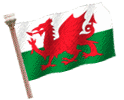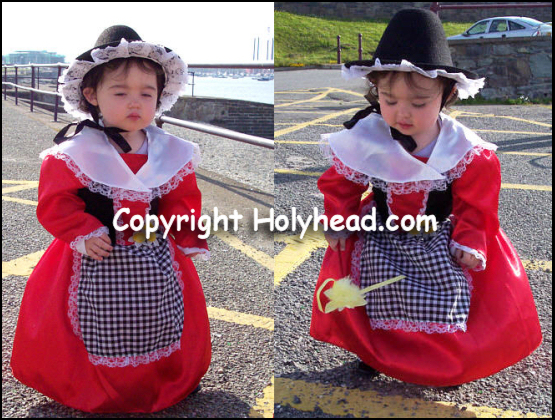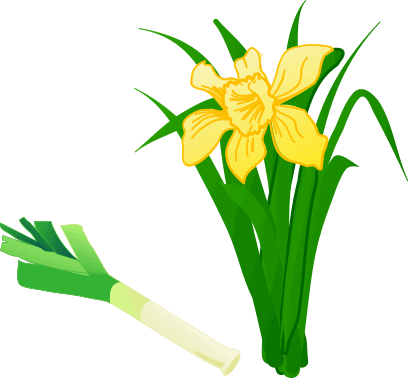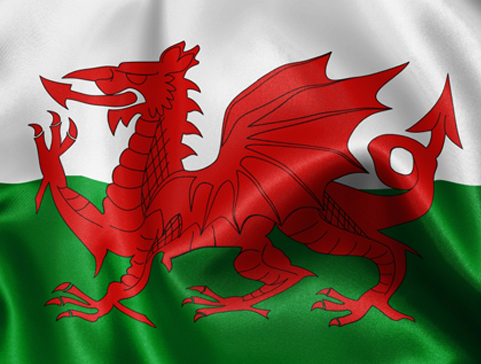Welsh Traditions



The tradition of Welsh Love Spoons dates back to the 17th Century. They were developed from the “Cawl” (soup) spoon. Each spoon was lovingly carved out of a single piece of wood (usually sycamore) and was given as a token of affection by a lover to his girl. Every spoon was as individual as it’s carver, and therefore tells it’s own unique story. Hearts are common symbols on the spoons and of course symbolise the love the carver has for his girl. Chain links represent the links between the two lovers.
Peacocks – a wish for fertility
Horseshoe – for good luck (often found on wedding spoons)
Caged balls – fertility and security
The number of balls in each spoon represented the number of children the carver required from a marriage.
Key – carver wished to lock his girl in his heart.
When a couple emigrated they may be given a spoon containing a real seed – that they may plant in the new land and the plant would serve as a reminder of their home country – WALES.
The NATIONAL EISTEDDFOD of WALES Yr EISTEDDFOD GENEDLAETHOL
An annual event which dates back to the thirteenth century, in which you can see the WELSH culture come to life.
It is a festival of music, crafts and literature with “children of all ages”competing for their school, or
organisation. It is also a time to see old friends who have emigrated to far away lands and come home especially for the Eisteddfod.
Welsh Costume

The Welsh National Costume
The costume regarded as national dress is based on clothing worn by Welsh countrywomen during the early 19th century. It was a striped flannel petticoat, worn under a flannel open-fronted bedgown, an apron a shawl and kerchief or cap. The BEDGOWN – had a short front, long back and short sleeves ans was a practical jacket. The cloth was often of dark wool with blue or red stripes. A small scarf was worn around the neck. Separate cotton sleeves were worn as required. Some women wore a cloak over this when necessary – blue being more common in Wales than red. The SHAWL was an important part of the costume. These were normally large squares of black, cream or grey wool, sometimes checked. Another sort of shawl was used to carry a baby (siôl magu) leaving the women’s hands free to work. This was worn diagonally from one shoulder with the baby on one side. Fine brightly coloured cotton or silk shawls like the Paisley pattern were worn as ‘Sunday best’. Red shawls worn by women during the French invasion at Fishguard in 1797 are now rare. The APRON was normally of wool, often of white or grey checks or stripes dark background. Knitted stockings were sometimes worn by the women and the beginning of the 19th century these has no foot, They were hooked around a toe. Rural women often walked in bare-feet, but may have worn sturdy leather boots or wooden soled clogs with leather uppers. The tall ‘chimney’ hat didn’t appear until late 1840’s and may have been based on an amalgamation of and a form of high hat (worn during the 1790-1820 period in country areas) and men’s top hats. The hats worn in north Wales generally had a slightly shorter crown and straight sides- most of these were made by Welsh hatters.The crowns of the hats worn in south and south-west Wales were slightly conical in shape and most were made by Carver and Co of Bristol or Christys of London and Stockport. The Welsh hat seems to have been worn (with a full Welsh costume) only by the wives and daughters of successful farmers when attending chapelor church, at special events such as Royal visits and eisteddfodau and when selling their wares at market. The Welsh hat seem to have started to go out of fashion during the 1860’s,. A few women continued to wear them until the revival of the Welsh costume during the 1890’s. Most 20th century tall Welsh hats were made of cotton and card and were worn by members of folk dancers and women’s choirs and at special events. The hats now worn by girls on St David’s day are made of felt.
 Welsh Language
Welsh Language
The WELSH LANGUAGE – CYMRAEG is Europe’s oldest living language. It is a Celtic language and dates back to the 6th Century and just before the Romans left Britain. WELSH comes from the language spoken by the ancient Britons, called “Brythonic”.Welsh (Cymraeg or y Gymraeg, is a member of the Brythonic branch of Celtic spoken natively in Wales, in England by some along the Welsh border and in the Welsh immigrant colony in the Chubut Valley in Argentine Patagonia. There are speakers of Welsh throughout the world, most notably in the rest of Great Britain, the United States, Canada, Australia, and New Zealand. The most recent census figures (2001) presented in “Main Statistics about Welsh”[8] by the Welsh Language Board, indicate 582,400 (20.8% of the population of Wales in households or communal establishments) were able to speak Welsh and 457,946 (16.3%) can speak, read and write it. This compares with 508,100 (18.7%) for 1991. Increasing use of the English language had led to a decline in the numbers of Welsh speakers. Since the introduction of the Welsh Language Act 1993, giving Welsh equal status with English in the public sector in Wales, this has been slowed.[citation needed]The results of the “2004 Welsh Language Use Survey” indicate that there are 611,000 Welsh speakers in Wales (21.7% of the population living in households, a lower figure of 19.7% is given in the same paper), 62% claim to speak Welsh daily, and 88% of those fluent in the language speak it daily.[8]The 2004 and 2001 figures both suggest that around 14% of the Welsh population claim to speak Welsh daily. It is notable that the figures are from a survey and so fluency was not tested; however, fluency in the 2004 survey (versus a 1992 survey) was only greater in the 3-15 years age group (p.9) and that most of this increase came in the South East (p.10), in all other groups numbers of fluent speakers had declined. See Welsh English, sometimes known as “Wenglish”, for the English language as spoken in Wales. Officially, the English and Welsh languages have equal status in Wales.
Welsh Emblem
The WELSH NATIONAL EMBLEMS
The DAFFODIL& The LEEK
They share the Welsh name: CENHINEN

Welsh Flag


The Welsh flag has two equal horizontal stripes in white and green. has a large red dragon passant. The dragon on the flag must face to the left, be centrally sited and cover equal parts of the white and green panels. The dragon standard was perhaps first seen in Britain in the shape of a standard carried by the cohorts of the Roman legion – the “Draco”. The Romans were inspired by the dragon standard carried by their Parthian and Dacian and enemies and had adopted this device by the third century. When the Roman legions withdrew in the 4th century, the British were left to face Saxon attacks, the dragon would have been a symbol for those who wanted to preserve their Romanised way of life. The ancient poets Aneirin and Taliesin use” ddraig” – the Welsh word for dragon in the sense of “leader” or “warrior” and this usage remained till the Middle Ages. In the story of the red dragon battling with the Saxon white dragon around 800 AD in the Historia Brittonum, the dragon was seen as a symbol of national independence. The dragon symbol seems to hav been used by both sides at the Norman invasion of England in 1066. Tudor ancestors of Jasper Tudpr amd King Henry VII. Edmund had a dragon as crest and supporter to the arms granted them by Henry VI. When Henry Tudor faced King Richard III in 1485 at the battle of Bosworth, his battle standards numbered three. One standard carried the arms of St. George of England, another the arms of the house of Beaufort and another was a “Red ffyry dragon peyntid upon white and Grene Sarcenet”. It is said that this dragon banner represented Henry Tudor’s claim to be a true representative of the ancient Kings of Britain and that it served as his tribute to the Welsh people who had made his victory possible.
 Welsh Recipes
Welsh Recipes 
CAWL – SOUP
2lb WELSH LAMB
1/2lb CARROTS
1lb POTATOES
1 SWEDE
2 LEEKS
1/2oz FLOUR
2oz PARSLEY
Salt & Pepper.
Dice meat and place in a saucepan add carrots, swede, and white of leeks Simmer for two and a half hours, Thicken with flour & water when potatoes are almost ready, Add parsley and green of leeks Simmer for 10 minutes Serve hot with bread …… DELICIOUS!!
BARA BRITH – FRUIT LOAF
3lb FLOUR
3/4lb BROWN SUGAR
3/4lb BUTTER
2 or 3 EGGS
1lb CURRANTS
1lb RAISINS
1lb SULTANAS
1/4lb CANDIED PEEL
1 Teaspoon SALT
1oz YEAST
MILK
Mix yeast with warm milk
Rub fat into the flour
Mix dry ingredients
Make a well in centre and add yeast
Mix into soft dough
Cover and leave to stand for an hour and a half in a warm place until it’s twice original size
Place in greased loaf tin and stand again for 25 mins
Bake in oven for 1 – 2 hour
DELICIOUS served HOT or COLD hot or cold with butter!
TEISENNAU CYMRAEG – WELSH CAKES
8oz FLOUR
3oz WALNUTS
1/2 Teaspoon BAKING POWDER
2oz LARD
1 EGG
1/4 Teaspoon MIXED SPICE
Salt
Rub fat into flour
Add dry ingredients
Add egg
Add milk
Mix to a stiff paste
Roll out and cut
Bake on griddle or hot plate
Delicious warm,
spread with butter and sprinkled with sugar!
STWNSH RWDAN A IAU – TURNIP MASH WITH LIVER
( A popular dish in North Wales)
INGREDIENTS:
LIVER , ONIONS, SWEDES, POTATOES, FLOUR, BUTTER.
Cut liver into slices and fry until dark in colour Roll pieces in a little flour Slice onions, fry them, then roll them in flour Place liver &onions in saucepan, cover with water Simmer for 2 – 3 hours Boil potatoes and Swedes and mash together with a little onion and butter.
